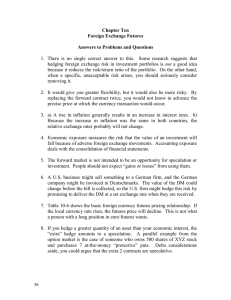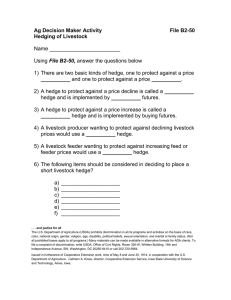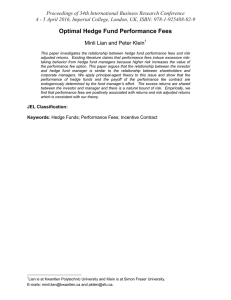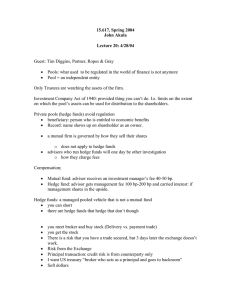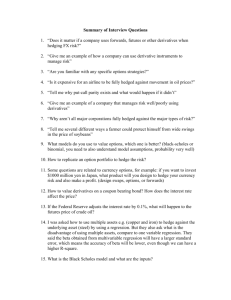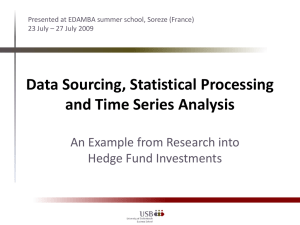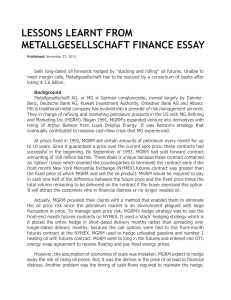Options and Futures Markets Introduction to Derivative Markets
advertisement
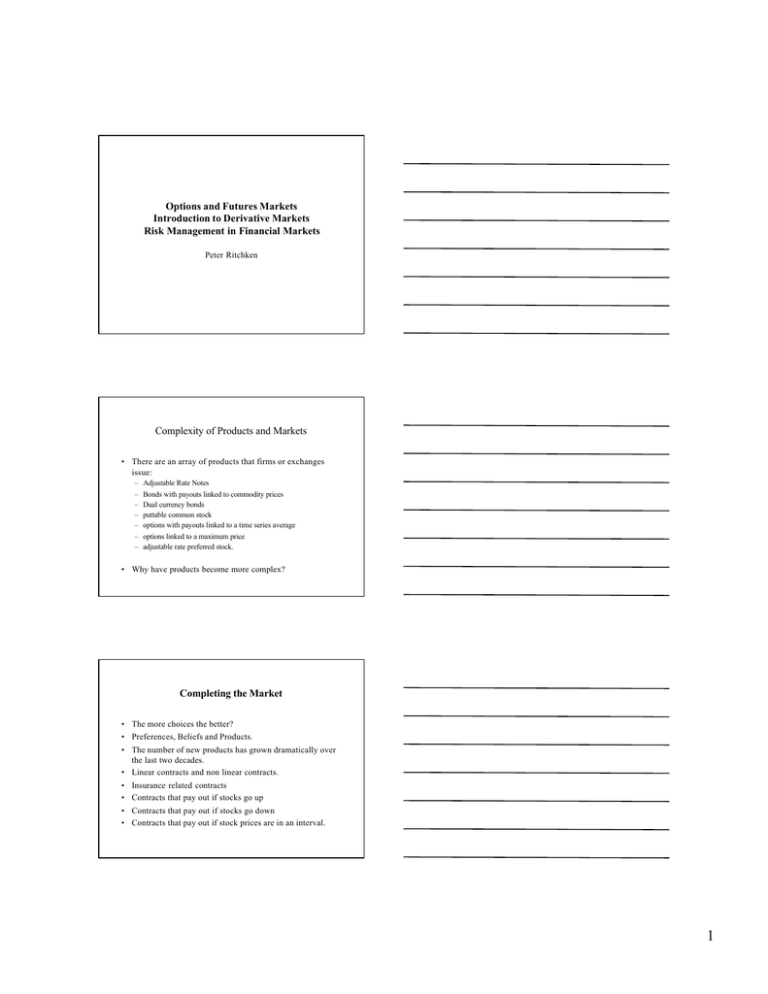
Options and Futures Markets Introduction to Derivative Markets Risk Management in Financial Markets Peter Ritchken Complexity of Products and Markets • There are an array of products that firms or exchanges issue: – – – – – – – Adjustable Rate Notes Bonds with payouts linked to commodity prices Dual currency bonds puttable common stock options with payouts linked to a time series average options linked to a maximum price adjustable rate preferred stock. • Why have products become more complex? Completing the Market • The more choices the better? • Preferences, Beliefs and Products. • The number of new products has grown dramatically over the last two decades. • Linear contracts and non linear contracts. • Insurance related contracts • Contracts that pay out if stocks go up • Contracts that pay out if stocks go down • Contracts that pay out if stock prices are in an interval. 1 The world has become a risky place. • Living is risky----Life Insurance • Houses are risky---Fire Insurance • Stock Markets are risky--• Commodities are risky---• Interest Rates are risky---• Foreign Exchange is risky--- As an individual what risks should I bear? • How do I choose which risks to bear, and which risks to hedge? • How do I hedge the risks which I do not want to bear? • Will I get ripped off when I insure against these risks? • What maturity contracts should I purchase? • Where do I get these contracts? • Some risks are diversifiable , others are not. How do I price them? The world has become a risky place! • Financial markets have responded to risk by offering innovative products – insurance products – hedging products – limited liability products # different products 1900 1970 2000 Time 2 From the Firm’s Perspective • To what extent is my firm exposed to interest rates, FOREX, commodity price risk? • What financial tools are available for managing these exposures? • If my firm is exposed, how do I use the tools to manage the exposure? • Should a firm hedge risk? – Can’t the individual hedge more efficently? – Examples Reasons for the Firm to hedge • What would M. and M. say? • Reduce Taxes • Reduce Costs of Distress • Cheaper ( transaction costs and size) • Special Information • We will have more to say about this! Regulation and Strategy • An Ohio Widget Company – Should it hedge against FOREX risk? – Should it hedge if we know our competitor is hedging? – Consequences of information disclosure? 3 What will you learn? • How to use Futures Markets. • How to use Option Markets • How to use OTC markets • How to go about designing a risk management program • How to transfer risk that you are not willing to bear, at a reasonable price. • How not to get ripped off. • How to ask the right questions, and use markets to your advantage. • How to communicate the risk management needs faced by your firm, and to isolate the steps needed to solve the problem • To understand how technology impacts markets, how foreign competition affects product decisions, and to be aware of how risk managers respond to changes. • To explain why certain products and strategies create value while others do not. What will you learn? • To PRICE derivative products • To understand how all corporate securities can be viewed as complex options, and to value them. • To understand how option pricing theory can be used in capital budgeting and strategic planning. • To appreciate how flexibility in projects and financial instruments can be valued. • To better understand why index ammortization swaps, collateralized mortgage obligations, liquid yield option notes, lookback options, and other exotic contracts exist. • To understand a day in the life of a trader and a financial engineer. 4 An Example of an Exotic Claim • Average Rate Options Price 1 2 3 4 Time Background Material • Interest Rates 1 → (1 + rn ) nT 1 → erT B( 0,T ) → $1 B( 0,T ) = e− rT Example • r is 6% continuously compounded. • T = 0.25 year. • B(0,T) = exp(-rT) = exp( -0.06/4) 5 The Law of One Price • Two investments that generate exactly the same cash flows at the same times, should be priced the same. • If they were not, what would you do? – Buy the cheap. – Sell the expensive – Pocket the difference. • We will use this idea, over and over again! Main Topics • Forwards and Futures Markets • Pricing Forward and Futures • Hedging with Futures • Option Markets • Option Strategies • Arbitrage Relationships • Pricing with lattices • Pricing with Black Scholes Main Topics • The Greeks and Risk Management • Extension of the Black Scholes Model • Exotic Options and Corporate securities • Computer Simulation and pricing e xotics • Why do firms hedge? • Special Topics – – – – Real Options Case Studies Disasters with options value at risk 6
